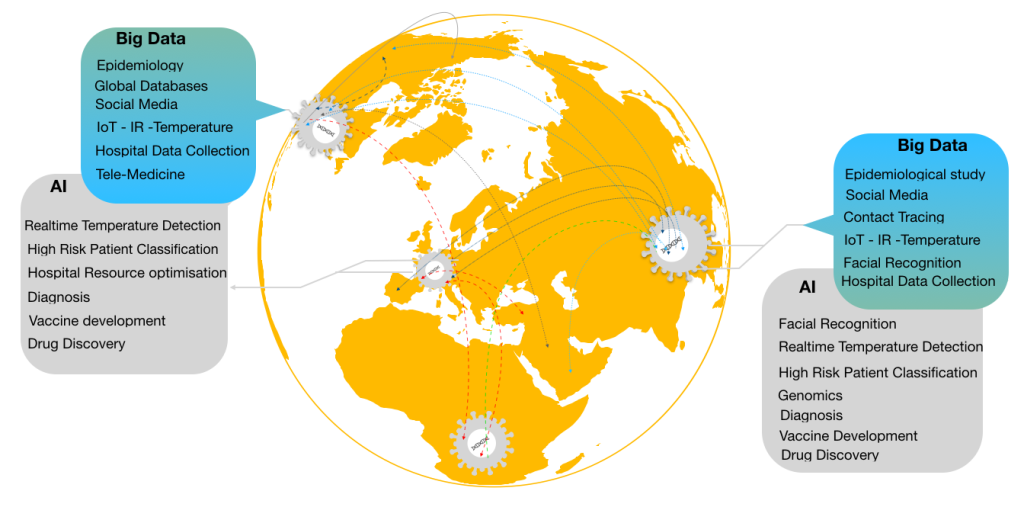
- +41 41 201 88 44
- [email protected]
- Mon-Fri 8am - 6pm
COVID-19 has surprised the world with its artillery of tricks to create a pandemic with unfathomable loss of human life, social behaviour , the economy and our way of life for the foreseeable future. How can we deal with these challenges and positively deal with he pandemic and be prepared for future. In the last 4 months every nation is being tested for its preparedness and also tremendous stress test on their available infrastructure and trained workforce. Finally how swiftly each country can mobilise and deploy the available technology, tools and the people (the brave hero’s) to tackle the worst pandemic of our times.
Last decade has seen tremendous advancements in digitalisation of the world and analytic capabilities. The multitude of advances in AI and big data are being put to test in the current state of world affairs. COVID-19 pandemic has put to test the most advanced countries and the existing technology to its outer bounds. And made us realise the lack of preparedness for such an adverse event. This leads us to ask the fundamental questions about technology like AI; can AI as a new tool for crafting solutions for real world problems be instrumental in contributing to some of the key steps in our fight to tackle this pandemic. Can AI help track and predict the spread of the virus? Can AI help in delivering the correct information to the people. Can AI help in swift diagnosis and prognosis of the COVID-19 cases? Can AI help us identify new medicines and develop vaccines for COVID-19? Can AI have a positive impact on the post pandemic world. What are the challenges in the way to achieve AI’s full potential in this fight against COVID-19? Lets have a discussion to see if AI can meet the various challenges or not!
The transformational digital technologies that can contribute and make a difference in our fight against COVID-19 are AI (both machine learning and Deep learning methods) , Big Data, IoT (Internet of Things) and Blockchain technology. All these technologies yield great results when deployed in conjunction as they are connected and cross functional. Thus forming a robust pipeline ensuring the data flow and availability for advanced modelling and analytics leading to better epidemiological understanding in stopping the spread of the virus. And also in building strategies to tackle diagnosis and development of new diagnostics, treatments and possible vaccines in the long run. Lets have a critical look of in what ways AI and other technology were helpful and what is yet to be improved to make an impact on this global fight against this pandemic.

Of the ways to handle the pandemic, the established strategies to fight and tackle COVID-19, the first steps are monitoring and surveillance of the disease, diagnostic approaches and spread of the disease. second, is to mitigate by deploying strategies to combat the spread, identify and develop medication to treat the pandemic.
First and the fore most application of AI technology in this pandemic has been in tracking and understanding the spread of the disease. At the start of the pandemic China has implemented AI in for facial recognition and IR imaging to check for temperature of the commuters and citizens. This gave a fast way to check millions of people at airports, railway stations and populated places in the city. This involves a huge amount of effort in utilising AI, Big data and IoT technologies. Another way of predicting spread is to use the big data acquired from various sources like google, social media posts, apps and travel agencies of the state for tracing viral activity, prevalence and level of infectivity. Thus localising the next pockets of possible local outbreaks in the community. Though there is large deviations in predictions due to lot of noise in the social media data.
Initially, epidemiologists used classical epidemiological SIRE models rather than just AI models to predict. This is based on the fact that AI needs good quality historical data for building good model. This was not available initially, but as more and more data came in some hybrid models were built using both classical epidemiological models and AI techniques which improves the predictions. Some of the institutions developed information centres like Worldometer, Johnhopkins centre for Systems Science Engineeering, CDC and Chinese CDC have established databases to keep track of the number of infections, the mortality rates and number of recovered people. Others like Tableau and Amazon have crated dashboards for users to build and visualise the progression of COVID-19 infection. IoT platforms along with AI for public health agencies provided access to data for health monitoring and realtime update of the number of people infected with the COVID-19 virus.
In china, facial recognition technology was used to identify and track peoples movement and thus help trace the contacts of the infected people. Though these actions seem to be beneficial in the short run there has to be responsible use of such technology and a global oversight to avoid misuse post pandemic. And to keep track of evolving pockets of infection, the key is to develop new models with high granularity including all the available information about the demographics of the local population, culture, the core structure of the family, working status and the socio-economic stratification. Current epidemiological models do not consider high granularity of data from various sources. Such models when coupled with big data from travel information and social networks can help us map the spread of the virus in an accurate way. Thus, over a period of time we will understand the nature of the spread of the virus and in a reemergence of the covid-19 we can block the key modes of spread, limiting the spread of the virus and the damage caused due to infections.
Early detection and diagnosis of the virus infection is key step in preventing the disease spread. AI can quickly analyse irregular symptoms and hints that helps to provide faster decision making, which is cost-effective both interns of human resources and time, which is of essence given the urgency of spread. Accurate, quick and low cost tests for the diagnosis of positive cases of COVID-19 are essential to understand the virus penetrance into the population and its biology. People who are asymptomatic carriers of viruses are needed to be tested for antibodies. These data and statistics over the time will improve our understanding of the virus. Alternative ways to detect the virus are essential as testing large populations is essential to build datasets of COVID-19 cases that will help improve the accuracy of the algorithms. And these algorithms can be used for initial screening of patients, unloading some of the stress, the hospitals had during this surge of infected (mild to severe) people to ICU’s and critical care units.

After identification and tracking of the virus and the infected population the next steps is to mitigate the spread of the virus with mitigation strategies involving restrictions of population movement and lockdown of businesses, gatherings and sometimes extreme quarantine. This situation has tremendous implications on people with medical conditions other than COVID-19 related. Many countries have closed medical services to other patients in this current lockdown. This caused delays in urgent surgeries and necessary medical services. In such scenarios, telemedicine will help lower the burden on the patients as well as the doctors and hospital staff.
Using various AI based algorithms hospitals can help manage the flow of patients their initial assessment and clustering into mild severe and critical cases based on the aetiology. Also predict mortality risk by adequately analysing the previous health data of the patients, giving prioritisation schedules for critically limited medical supplies, medication and medical devices. Thus relieving the doctors in the ICU and frontline health staff of extra workload and risk. It is here that AI can help improve the efficiency of medical services in the hospitals by taking care of diagnostic X-ray and CT scans of infected patients. Typically, doctors will take around few minutes to approximately 30min based on experience to evaluate an x-ray or CT scan respectively, whereas recently developed AI algorithms can do the same evaluation in 10 seconds to few minutes thus help reduce the workload and provide doctors extra time for other critically needed patients. Though its not a norm at many hospitals to deploy algorithms for diagnosis, these are the times which give us an opportunity for evaluation and adoption of such novel solutions.
Currently many companies and research labs are developing very rapid and accurate tests for COVID-19. Detection of the infected population is a first step towards the next mitigating steps for isolation of the infected person and prevent spread of the disease to the family and in the community. We have seen that countries have utilised drones and whats app to control movement of people and also to disperse information to the public directly to avoid misinformation. Thus can enhance public health education and communication. Using Natural Language Processing(NLP), Speech recognition and chatbots from health authorities to dispense realtime efforts and precautionary information. Inspire of all the essential steps and technologies there will be gaps and misinformation during this pandemic which can be tracked with AI.
Recently big tech companies have built apps that can give governments access to the information about their customers that was not previously accessed, in an attempt to restrict the spread and contain COVID-19 virus. But this comes with some privacy issues and need to be critically evaluated before widespread acceptability. The same goes true for AI and other technologies, which need to be interpretable and responsible for their application in critical areas for diagnosis, treatment and in the hospitals.
Already, AI and big data have helped in this fight against at the COVID-19 in various ways and at different levels in diagnosis, clinical data analysis and management of hospital resources and stop spread of infections. On the brighter side we have been able to use these technologies and test their limitations in curbing the spread and minimise the loss during this pandemic. There is going to be a very fruitful outcomes from this synergy of forces between the myriad technologies like AI, Big-data, IoT and innovations in drug discovery to vaccine development in building our future defences against broader global risks. The COVID-19 has opened our eyes to an alternate reality, which can be more realistic and imminent than we imagined. The only key aspect is to be more human and augment our intelligence with technology and strive to prevent another pandemic.
Resources for reliable COVID-19 information and Analysis:
Worldometer:
https://www.worldometers.info/coronavirus/
John Hopkins University, JHU CSSE:
https://coronavirus.jhu.edu/map.html
Centre for Disease Control and Prevention, US:
https://www.cdc.gov/coronavirus/2019-ncov/index.html
Tableau COVID-19 Data Hub:
https://public.tableau.com/profile/covid.19.data.resource.hub#!/
Steinentorstrasse 35 , 4051 Basel, Switzerland